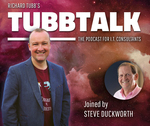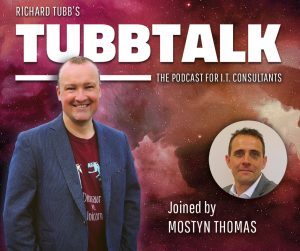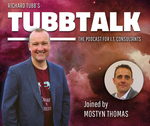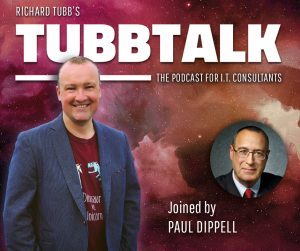Richard Tubb's Blog, page 68
August 26, 2018
How to make MSP billing and project management easier – TubbTalk #34
Richard talks to Steve Duckworth, CEO of Harmony PSA, about how their automation software can help MSP billing and the four different ways that MSPs can use it to sell.
An Interview with Steve Duckworth
 How did Harmony PSA Come About?
How did Harmony PSA Come About?The PSA software was built in response to a need that Steve identified in a previous role, where there was a need for a more effective order management system. Steve noticed that the core reporting was good, but at the point of sale, the information wasn’t recorded properly, meaning that incorrect details were used on the order paperwork.
It was initially aimed at ISPs (internet service providers), to give them an order processing system with timesheets and billing. Later on, Steve and his business partner saw the potential for the software to be used by MSPs (managed service providers).
How does Harmony Work?
Harmony has a rich and powerful product engine at its core and sells in four major ways – transactionary, recurring, pre-payment and consumption. Steve says that within those four major subclasses there is an infinite variation, and explained how each works:
Transactionary: Is focused on time or selling a one-off item. The system generates an email which can be delivered by a project
Recurring: This is stable revenue that a company can predict and knows it will continue to generate in the future with a high level of certainty
Pre-payment: Also known as a ‘block hours contract’, Harmony’s version differs because they have a flexible model which also includes cash or tokens, and each choice can be applied to the same customer
Consumption: Billing by a device, which can be automated with your RMM (remote monitoring and management) to run queries and automate invoices
How Harmony PSA Differs from its Competitors
Many MSPs complain that the tools they use within their business require them to adopt the tools’ methodology too, which is something they don’t always want to do. What Harmony does is to ask the MSP how they run their business and adapts to that instead.
Steve explains that a key design principle for Harmony is flexibility, and while they won’t version the code, they do put a lot of effort into reconfigurability. The MSPs are given a platform where they can model their business and change it whenever they want without having to replace the software.
Harmony’s Range of ‘Multi’ Options
Harmony has been designed to provide MSP users with a range of options for all aspects of the platform, which they term ‘multis’. These include:
Multi-currency: Harmony stores every financial transaction in three currencies: the transaction currency, the legal entity accounting currency and the consolidation currency, as well as being a real-time consolidation engine
Multi-legal: The build has the tax rules and account codes integrated, as well as its own finance interface so you can run a multinational group in a single instance of Harmony
Multi-country: This is useful for timesheets and invoices, allowing staff in one country to work on a project in another country. Their timesheets appear on the invoice, and Harmony resolves transfer prices for costs too
Multi-lingual: This feature works throughout the Harmony software, including in PDFs and other documentation. Initially introduced for German resellers, the 25,000 code changes the developers made now mean that they can add a language pack in a week. It also integrates with Microsoft Culture 7 to make it multi-culture
Multi-time-zone: Harmony supports overnight time zones, allowing MSPs to outsource to a company in India (for instance) and Harmony’s ticket SLAs (service level agreements) can understand the time zone
Mentioned in this Episode
Datalogic
Solarsoft
Microsoft Culture
Salesforce
SolarWinds MSP
Ninja
BlueSnap
Zapier
Interview Transcript
Download the Transcript

Download the transcript of "How Harmony PSA makes billing and project management easier - TubbTalk #31".
Success! Now check your email to confirm your details.
There was an error submitting your subscription. Please try again.
First Name Email Address We use this field to detect spam bots. If you fill this in, you will be marked as a spammer. Send me the transcript We don't spam! Unsubscribe at any time. Powered by ConvertKit /* Layout */ .ck_form { /* divider image */ background: #fff url(data:image/gif;base64,R0lGODlhAQADAIABAMzMzP///yH/C1hNUCBEYXRhWE1QPD94cGFja2V0IGJlZ2luPSLvu78iIGlkPSJXNU0wTXBDZWhpSHpyZVN6TlRjemtjOWQiPz4gPHg6eG1wbWV0YSB4bWxuczp4PSJhZG9iZTpuczptZXRhLyIgeDp4bXB0az0iQWRvYmUgWE1QIENvcmUgNS41LWMwMTQgNzkuMTUxNDgxLCAyMDEzLzAzLzEzLTEyOjA5OjE1ICAgICAgICAiPiA8cmRmOlJERiB4bWxuczpyZGY9Imh0dHA6Ly93d3cudzMub3JnLzE5OTkvMDIvMjItcmRmLXN5bnRheC1ucyMiPiA8cmRmOkRlc2NyaXB0aW9uIHJkZjphYm91dD0iIiB4bWxuczp4bXA9Imh0dHA6Ly9ucy5hZG9iZS5jb20veGFwLzEuMC8iIHhtbG5zOnhtcE1NPSJodHRwOi8vbnMuYWRvYmUuY29tL3hhcC8xLjAvbW0vIiB4bWxuczpzdFJlZj0iaHR0cDovL25zLmFkb2JlLmNvbS94YXAvMS4wL3NUeXBlL1Jlc291cmNlUmVmIyIgeG1wOkNyZWF0b3JUb29sPSJBZG9iZSBQaG90b3Nob3AgQ0MgKE1hY2ludG9zaCkiIHhtcE1NOkluc3RhbmNlSUQ9InhtcC5paWQ6MUQ5NjM5RjgxQUVEMTFFNEJBQTdGNTQwMjc5MTZDOTciIHhtcE1NOkRvY3VtZW50SUQ9InhtcC5kaWQ6MUQ5NjM5RjkxQUVEMTFFNEJBQTdGNTQwMjc5MTZDOTciPiA8eG1wTU06RGVyaXZlZEZyb20gc3RSZWY6aW5zdGFuY2VJRD0ieG1wLmlpZDoxRDk2MzlGNjFBRUQxMUU0QkFBN0Y1NDAyNzkxNkM5NyIgc3RSZWY6ZG9jdW1lbnRJRD0ieG1wLmRpZDoxRDk2MzlGNzFBRUQxMUU0QkFBN0Y1NDAyNzkxNkM5NyIvPiA8L3JkZjpEZXNjcmlwdGlvbj4gPC9yZGY6UkRGPiA8L3g6eG1wbWV0YT4gPD94cGFja2V0IGVuZD0iciI/PgH//v38+/r5+Pf29fTz8vHw7+7t7Ovq6ejn5uXk4+Lh4N/e3dzb2tnY19bV1NPS0dDPzs3My8rJyMfGxcTDwsHAv769vLu6ubi3trW0s7KxsK+urayrqqmop6alpKOioaCfnp2cm5qZmJeWlZSTkpGQj46NjIuKiYiHhoWEg4KBgH9+fXx7enl4d3Z1dHNycXBvbm1sa2ppaGdmZWRjYmFgX15dXFtaWVhXVlVUU1JRUE9OTUxLSklIR0ZFRENCQUA/Pj08Ozo5ODc2NTQzMjEwLy4tLCsqKSgnJiUkIyIhIB8eHRwbGhkYFxYVFBMSERAPDg0MCwoJCAcGBQQDAgEAACH5BAEAAAEALAAAAAABAAMAAAICRFIAOw==) repeat-y center top; font-family: "Helvetica Neue", Helvetica, Arial, Verdana, sans-serif; line-height: 1.5em; overflow: hidden; color: #666; font-size: 16px; border-top: solid 20px #3071b0; border-top-color: #3071b0; border-bottom: solid 10px #3d3d3d; border-bottom-color: #1d446a; -webkit-box-shadow: 0px 0px 5px rgba(0,0,0,.3); -moz-box-shadow: 0px 0px 5px rgba(0,0,0,.3); box-shadow: 0px 0px 5px rgba(0,0,0,.3); clear: both; margin: 20px 0px; } .ck_form, .ck_form * { -webkit-box-sizing: border-box; -moz-box-sizing: border-box; box-sizing: border-box; } #ck_subscribe_form { clear: both; } /* Element Queries — uses JS */ .ck_form_content, .ck_form_fields { width: 50%; float: left; padding: 5%; } .ck_form.ck_horizontal { } .ck_form_content { border-bottom: none; } .ck_form.ck_vertical { background: #fff; } .ck_vertical .ck_form_content, .ck_vertical .ck_form_fields { padding: 10%; width: 100%; float: none; } .ck_vertical .ck_form_content { border-bottom: 1px dotted #aaa; overflow: hidden; } /* Trigger the vertical layout with media queries as well */ @media all and (max-width: 499px) { .ck_form { background: #fff; } .ck_form_content, .ck_form_fields { padding: 10%; width: 100%; float: none; } .ck_form_content { border-bottom: 1px dotted #aaa; } } /* Content */ .ck_form_content h3 { margin: 0px 0px 15px; font-size: 24px; padding: 0px; } .ck_form_content p { font-size: 14px; } .ck_image { float: left; margin-right: 5px; } /* Form fields */ .ck_errorArea { display: none; } #ck_success_msg { padding: 10px 10px 0px; border: solid 1px #ddd; background: #eee; } .ck_label { font-size: 14px; font-weight: bold; } .ck_form input[type="text"], .ck_form input[type="email"] { font-size: 14px; padding: 10px 8px; width: 100%; border: 1px solid #d6d6d6; /* stroke */ -moz-border-radius: 4px; -webkit-border-radius: 4px; border-radius: 4px; /* border radius */ background-color: #f8f7f7; /* layer fill content */ margin-bottom: 5px; height: auto; } .ck_form input[type="text"]:focus, .ck_form input[type="email"]:focus { outline: none; border-color: #aaa; } .ck_checkbox { padding: 10px 0px 10px 20px; display: block; clear: both; } .ck_checkbox input.optIn { margin-left: -20px; margin-top: 0; } .ck_form .ck_opt_in_prompt { margin-left: 4px; } .ck_form .ck_opt_in_prompt p { display: inline; } .ck_form .ck_subscribe_button { width: 100%; color: #fff; margin: 10px 0px 0px; padding: 10px 0px; font-size: 18px; background: #0d6db8; -moz-border-radius: 4px; -webkit-border-radius: 4px; border-radius: 4px; /* border radius */ cursor: pointer; border: none; text-shadow: none; } .ck_form .ck_guarantee { color: #626262; font-size: 12px; text-align: center; padding: 5px 0px; display: block; } .ck_form .ck_powered_by { display: block; color: #aaa; } .ck_form .ck_powered_by:hover { display: block; color: #444; } .ck_converted_content { display: none; padding: 5%; background: #fff; }Connect with me
Subscribe to TubbTalk RSS feed
Subscribe, rate and review TubbTalk in iTunes
Subscribe, rate and review TubbTalk on Stitcher Radio
Follow @tubblog on Twitter
You Might Also Be Interested In
I’ve bought Professional Services Automation software. What next?
Which business processes can you automate today?
Why do more IT outsourcers not outsource more?
The post How to make MSP billing and project management easier – TubbTalk #34 appeared first on Richard Tubb.



August 23, 2018
DesignEvo – Online Logo Maker
 Every Friday I share one of my favourite finds of the week — a website, tool or an app that has impressed me.
Every Friday I share one of my favourite finds of the week — a website, tool or an app that has impressed me.
My Friday Favourite this week is DesignEvo – Online Logo Maker.
What is it?
DesignEvo is an online logo maker.
How can it help me?
If you need to design a logo in a hurry, then DesignEvo can help you do that with minimum effort.
I’ve written before about outsourcing and how to find a good Virtual Assistant for your business. I have a fantastic graphic designer on Team Tubb in Col Gray of Pixels Ink. If you’re new to outsourcing, then services such as Fiverr allow you to work with graphic designers for simple projects too.
DesignEvo sits in between those two scenarios. Perhaps you have an idea for a logo and need to produce something quickly, but don’t have the graphic design expertise to pull it off. In this scenario, DesignEvo can help.
 DesignEvo is an online logo maker app that provides you with 6000+ templates, icons, fonts and more, to help you produce a good looking logo within seconds.
DesignEvo is an online logo maker app that provides you with 6000+ templates, icons, fonts and more, to help you produce a good looking logo within seconds.
For instance, my friends Roger Edwards, Pascal Fintoni and I are shortly launching a new Podcast called “3 Geeks and a Mic”. DesignEvo allowed me to produce the logo (pictured right) inside 3 minutes — and I have *zero* expertise in graphic design.
Not bad!
How much does it cost?
DesignEvo is free to use, and you can use any logos you create for free, as long as you give credit to DesignEvo.
You can also pay between $19.99 and $39.99 to download your logo for commercial use, without having to give credit, and with you owning the copyright.
How can I get it?
 Visit DesignEvo and start creating your first logo now.
Visit DesignEvo and start creating your first logo now.
You can also visit the DesignEvo Facebook page, follow @DesignEvoApp on Twitter, or follow DesignEvo on Google+.
You Might Also Be Interested In
Brain.fm – Music to improve focus, meditation and sleep
Bounce – An easy way to share ideas on a website
Website Grader – Check How Strong Your Website Is
The post DesignEvo – Online Logo Maker appeared first on Richard Tubb.



August 20, 2018
Webinar – If I were to start an MSP again: Tips for Building Business Relationships
 A heads-up that the third in my series of webinars with Kaseya on building a Managed Service Provider (MSP) business takes place on Wednesday, August 29th at 3 pm GMT (10 am EST). It’s entitled “Tips for Building Business Relationships”.
A heads-up that the third in my series of webinars with Kaseya on building a Managed Service Provider (MSP) business takes place on Wednesday, August 29th at 3 pm GMT (10 am EST). It’s entitled “Tips for Building Business Relationships”.
In each of the webinars, I offer my perspective as a former Managed Service Provider (MSP) owner and suggest what I would do if I were to start an MSP business again.
In our first webinar (which you can still view on demand) I shared The 3 Steps Successful MSPs implement in Operations.
In the second webinar (which you can also view on demand) I shared 3 Steps to Sales & Marketing success.
With this final webinar, we’ll be looking at a massively underrated and hugely important part of growing a large and successful MSP business — Building Business Relationships.
Tips for Building Business Relationships
Put simply, you cannot grow a successful business on your own. No man is an island, and no MSP has ever grown without assistance from others.
In this interactive webinar, I’ll be joined by MSP expert, Jim Lippie, of Kaseya. We’ll be offering practical, actionable steps on how you can start to build better relationships with your clients, your peers, your suppliers and the wider business community.
How to register for the webinar
This series of webinars are all free to attend, and even if you can’t make the live event, you should register anyway to be sent a link to the post-webinar on-demand recording.
You can register for our Webinar on Building Business Relationships now.
We’ve had great feedback on these sessions. I hope you can join us live!
What business relationships do you think you need to build for your own business? Do you partner well with vendors? Have you collaborated with your peers? Leave a comment below, send me a tweet @tubblog or get in touch — we’ll be answering the best questions live on our webinar.
You Might Also Be Interested In
What is a Managed Service Provider? My definition of an MSP
Why Your MSP Business Will Never Be Completed
How to build a successful MSP from scratch
The post Webinar – If I were to start an MSP again: Tips for Building Business Relationships appeared first on Richard Tubb.



August 19, 2018
How an MSP can thrive in the security niche – TubbTalk #33
Richard speaks to Norb Doeberlein, CEO of Netzbahn, about successfully running an IT company in a niche and the challenges of managing client security requirements.
An Interview with Norb Doeberlein
 Who is Norb Doeberlein?
Who is Norb Doeberlein?Norb has been in the IT industry for 30 years. He started out by hacking into the climate systems at his university, turning temperatures up and down. He also learned to talk his way out of trouble!
After graduation, he worked for a time in a computer store before setting out on his own, which he says was a learning curve. His business has progressed from being hardware-based to business-solutions based and explains that the key is combining what the client needs with the technology available.
Who is Netzbahn?
Netzbahn provides IT support, consultancy, everything that goes along with that, to government and law enforcement in the Wisconsin area. There is a team of nine, and Norb describes them as engineer supervisors, helping clients write and evaluate requests for proposals (RFPs).
Their main job is vendor management because, in law enforcement, every service provided is managed by a company with a state contract. Netzbahn ensures that the police are following the guidelines set out for them by Homeland Security.
Why They Don’t Have Competitors in Their Niche
Norb explains that the service they provide is to manage and support existing IT providers within the government or police force. The work is quite complex, which is why it requires specialist support.
To work within this part of the public sector, it’s essential to understand the 600+ page CJIS (Criminal Justice Information Systems) guidelines manual used by the FBI and Homeland Security, which is not something that most MSPs (managed service providers are familiar with). Netzbahn are able to meet that need.
Netzbahn isn’t the only company operating in this space, but they are the only one working for cities with a population of 30,000 or below – larger companies target bigger cities and metropolitan areas. The smaller cities are often overlooked and tend not to have IT staff of their own, so Netzbahn supplement that by having systems in place so they can escalate tickets to their provider and to enhance communication.
The Challenges of Finding the Right Tools
In-house, Netzbahn uses Autotask as their PSA (professional service automation), but work with people who use ConnectWise, CommitCRM and other tools. They don’t subcontract to anyone, as they all work directly with the client.
When considering new tools, the most important factors are that they follow CJIS requirements and are secure. Tickets often contain information that needs to be kept confidential, but at the same time, the majority of information a municipality holds is in open records, which can be a challenge.
Norb explains that if an MSP wants to deal with one or more municipality, everything needs to be within a CJIS-compliant data centre, including RMM (remote monitoring and management) tools, sync services, file sync utilities, offsite backup and BDR (backup disaster recovery) units.
The Positives of Working Within the Public Sector
Norb says that one of the best things about working in a secure and regulated industry is that processes move slowly, whether to start something or end it. This means that a business doesn’t put in a lot of work on a project only for the department to choose another provider.
Another big advantage is being paid in a timely fashion. Norb says that within the private sector, the norm is to wait 180 days to be paid, whereas with municipalities the average is 14 days, although Netzbahn is often paid within seven to 10 days.
To succeed in the niche, MSPs need to be patient. Although there are ups and downs, if they put the right contracts in place, their recurring revenue and additional services will guarantee a steady cheque.
Mentioned in this Episode
AutoTask
ConnectWise
CommitCRM
Netzbahn
Amazon FedRAMP
Azure
Anchor
Slack
Teamwork
Interview Transcript
Download the Transcript

Download the transcript of "How an MSP can thrive in the security niche - TubbTalk #33".
Success! Now check your email to confirm your details.
There was an error submitting your subscription. Please try again.
First Name Email Address We use this field to detect spam bots. If you fill this in, you will be marked as a spammer. Send me the transcript We don't spam! Unsubscribe at any time. Powered by ConvertKit /* Layout */ .ck_form { /* divider image */ background: #fff url(data:image/gif;base64,R0lGODlhAQADAIABAMzMzP///yH/C1hNUCBEYXRhWE1QPD94cGFja2V0IGJlZ2luPSLvu78iIGlkPSJXNU0wTXBDZWhpSHpyZVN6TlRjemtjOWQiPz4gPHg6eG1wbWV0YSB4bWxuczp4PSJhZG9iZTpuczptZXRhLyIgeDp4bXB0az0iQWRvYmUgWE1QIENvcmUgNS41LWMwMTQgNzkuMTUxNDgxLCAyMDEzLzAzLzEzLTEyOjA5OjE1ICAgICAgICAiPiA8cmRmOlJERiB4bWxuczpyZGY9Imh0dHA6Ly93d3cudzMub3JnLzE5OTkvMDIvMjItcmRmLXN5bnRheC1ucyMiPiA8cmRmOkRlc2NyaXB0aW9uIHJkZjphYm91dD0iIiB4bWxuczp4bXA9Imh0dHA6Ly9ucy5hZG9iZS5jb20veGFwLzEuMC8iIHhtbG5zOnhtcE1NPSJodHRwOi8vbnMuYWRvYmUuY29tL3hhcC8xLjAvbW0vIiB4bWxuczpzdFJlZj0iaHR0cDovL25zLmFkb2JlLmNvbS94YXAvMS4wL3NUeXBlL1Jlc291cmNlUmVmIyIgeG1wOkNyZWF0b3JUb29sPSJBZG9iZSBQaG90b3Nob3AgQ0MgKE1hY2ludG9zaCkiIHhtcE1NOkluc3RhbmNlSUQ9InhtcC5paWQ6MUQ5NjM5RjgxQUVEMTFFNEJBQTdGNTQwMjc5MTZDOTciIHhtcE1NOkRvY3VtZW50SUQ9InhtcC5kaWQ6MUQ5NjM5RjkxQUVEMTFFNEJBQTdGNTQwMjc5MTZDOTciPiA8eG1wTU06RGVyaXZlZEZyb20gc3RSZWY6aW5zdGFuY2VJRD0ieG1wLmlpZDoxRDk2MzlGNjFBRUQxMUU0QkFBN0Y1NDAyNzkxNkM5NyIgc3RSZWY6ZG9jdW1lbnRJRD0ieG1wLmRpZDoxRDk2MzlGNzFBRUQxMUU0QkFBN0Y1NDAyNzkxNkM5NyIvPiA8L3JkZjpEZXNjcmlwdGlvbj4gPC9yZGY6UkRGPiA8L3g6eG1wbWV0YT4gPD94cGFja2V0IGVuZD0iciI/PgH//v38+/r5+Pf29fTz8vHw7+7t7Ovq6ejn5uXk4+Lh4N/e3dzb2tnY19bV1NPS0dDPzs3My8rJyMfGxcTDwsHAv769vLu6ubi3trW0s7KxsK+urayrqqmop6alpKOioaCfnp2cm5qZmJeWlZSTkpGQj46NjIuKiYiHhoWEg4KBgH9+fXx7enl4d3Z1dHNycXBvbm1sa2ppaGdmZWRjYmFgX15dXFtaWVhXVlVUU1JRUE9OTUxLSklIR0ZFRENCQUA/Pj08Ozo5ODc2NTQzMjEwLy4tLCsqKSgnJiUkIyIhIB8eHRwbGhkYFxYVFBMSERAPDg0MCwoJCAcGBQQDAgEAACH5BAEAAAEALAAAAAABAAMAAAICRFIAOw==) repeat-y center top; font-family: "Helvetica Neue", Helvetica, Arial, Verdana, sans-serif; line-height: 1.5em; overflow: hidden; color: #666; font-size: 16px; border-top: solid 20px #3071b0; border-top-color: #3071b0; border-bottom: solid 10px #3d3d3d; border-bottom-color: #1d446a; -webkit-box-shadow: 0px 0px 5px rgba(0,0,0,.3); -moz-box-shadow: 0px 0px 5px rgba(0,0,0,.3); box-shadow: 0px 0px 5px rgba(0,0,0,.3); clear: both; margin: 20px 0px; } .ck_form, .ck_form * { -webkit-box-sizing: border-box; -moz-box-sizing: border-box; box-sizing: border-box; } #ck_subscribe_form { clear: both; } /* Element Queries — uses JS */ .ck_form_content, .ck_form_fields { width: 50%; float: left; padding: 5%; } .ck_form.ck_horizontal { } .ck_form_content { border-bottom: none; } .ck_form.ck_vertical { background: #fff; } .ck_vertical .ck_form_content, .ck_vertical .ck_form_fields { padding: 10%; width: 100%; float: none; } .ck_vertical .ck_form_content { border-bottom: 1px dotted #aaa; overflow: hidden; } /* Trigger the vertical layout with media queries as well */ @media all and (max-width: 499px) { .ck_form { background: #fff; } .ck_form_content, .ck_form_fields { padding: 10%; width: 100%; float: none; } .ck_form_content { border-bottom: 1px dotted #aaa; } } /* Content */ .ck_form_content h3 { margin: 0px 0px 15px; font-size: 24px; padding: 0px; } .ck_form_content p { font-size: 14px; } .ck_image { float: left; margin-right: 5px; } /* Form fields */ .ck_errorArea { display: none; } #ck_success_msg { padding: 10px 10px 0px; border: solid 1px #ddd; background: #eee; } .ck_label { font-size: 14px; font-weight: bold; } .ck_form input[type="text"], .ck_form input[type="email"] { font-size: 14px; padding: 10px 8px; width: 100%; border: 1px solid #d6d6d6; /* stroke */ -moz-border-radius: 4px; -webkit-border-radius: 4px; border-radius: 4px; /* border radius */ background-color: #f8f7f7; /* layer fill content */ margin-bottom: 5px; height: auto; } .ck_form input[type="text"]:focus, .ck_form input[type="email"]:focus { outline: none; border-color: #aaa; } .ck_checkbox { padding: 10px 0px 10px 20px; display: block; clear: both; } .ck_checkbox input.optIn { margin-left: -20px; margin-top: 0; } .ck_form .ck_opt_in_prompt { margin-left: 4px; } .ck_form .ck_opt_in_prompt p { display: inline; } .ck_form .ck_subscribe_button { width: 100%; color: #fff; margin: 10px 0px 0px; padding: 10px 0px; font-size: 18px; background: #0d6db8; -moz-border-radius: 4px; -webkit-border-radius: 4px; border-radius: 4px; /* border radius */ cursor: pointer; border: none; text-shadow: none; } .ck_form .ck_guarantee { color: #626262; font-size: 12px; text-align: center; padding: 5px 0px; display: block; } .ck_form .ck_powered_by { display: block; color: #aaa; } .ck_form .ck_powered_by:hover { display: block; color: #444; } .ck_converted_content { display: none; padding: 5%; background: #fff; }Connect with me
Subscribe to TubbTalk RSS feed
Subscribe, rate and review TubbTalk in iTunes
Subscribe, rate and review TubbTalk on Stitcher Radio
Follow @tubblog on Twitter
You Might Also Be Interested In
What the Datto and Autotask Merger Means for MSPs Worldwide – TubbTalk #26
Professional Services Automation. Does my MSP need a PSA?
A list of Professional Service Automation tools for MSPs
The post How an MSP can thrive in the security niche – TubbTalk #33 appeared first on Richard Tubb.



August 17, 2018
Photofeeler – Choose your business, social, and dating photos using hard data
 Every Friday I share one of my favourite finds of the week — a website, tool or an app that has impressed me.
Every Friday I share one of my favourite finds of the week — a website, tool or an app that has impressed me.
My Friday Favourite this week is Photofeeler – Choose your business, social, and dating photos using hard data.
What is it?
Photofeeler is a photo testing tool.
How can it help me?
I recently wrote about Crystal – Understand Yourself, Your Coworkers and Your Customers. Understanding yourself is one thing, but what does your social media profile picture say about you to others?
Photofeeler enables you to choose your business, social and dating photos using hard data about how you’re coming across to others.
You upload a selection of your profile pictures, and Photofeeler gathers feedback from respectful, unbiased voters who you can target by gender and age.
Photofeeler then uses artificial intelligence to ensure your results are accurate and trustworthy.
The end result is that you are given an unbiased opinion on which is the best profile photo to use for your business, social and other profiles.
If you’re not sure what your profile picture says about you, then Photofeeler will help you make the right choice on the photo to use.
How much does it cost?
Photofeeler is free to use if you participate and vote on others photos. You can also buy credits starting from $9.Profile
How can I get it?
 Visit PhotoFeeler.com to get signed up and begin to test your photos.
Visit PhotoFeeler.com to get signed up and begin to test your photos.
You can also visit the PhotoFeeler Facebook page, or follow @Photofeeler on Twitter.
Thanks to Ann Handley of MarketingProfs for sharing PhotoFeeler with me!
You Might Als Be Interested In
BestNine – Get your best nine photos of the year on Instagram
What are the social effects of Social Networking?
Social Networking is a life’s highlight reel, not the whole story
The post Photofeeler – Choose your business, social, and dating photos using hard data appeared first on Richard Tubb.



August 15, 2018
How to run a successful MSP in an area with no big businesses – TubbTalk #32
Richard talks to Mostyn Thomas about how he deals with the challenges of providing IT solutions in a small area and the tools he uses to make his Managed Service Provider (MSP), Astrix a success.
An Interview with Mostyn Thomas
 Who is Mostyn Thomas and What do Astrix do?
Who is Mostyn Thomas and What do Astrix do?Astrix IT Support is a pure-plan MSP (managed service provider) based in Wales. Mostyn started out providing services to schools, before moving into offering break/fix with managed services for businesses. As the market changed, the company moved to focus entirely on fully managed services.
Astrix has been going for 15 years, initially as an MSP, with a short spell in break/fix before changing to their current model. They charge a monthly or per user fee, with differing services depending on client need, which means there are no big bills or unexpected costs. Currently, only some of their clients are ‘pure MSP’ – so much per user, per month – but this is where Mostyn would like Astrix to be in a few years.
The Challenges of Working Only with Small Businesses
Mostyn explains that there’s an appetite in Wales to buy from local people first, before looking for suppliers elsewhere in the world, making them separate from the rest of the UK.
He says that South Wales also has very little large industry and is dominated by small businesses. The lack of big employers means that you have to adapt your services to those in your location, and have a number of clients rather than just three or four, as MSPs do in other parts of the country.
The majority of business owners are less likely to invest in costly equipment, and don’t invest in the top-level support services Astrix offers, so offerings need to be tailored to smaller companies.
Mostyn is keen to emphasise that people do see the value of service, particularly disaster recovery and data restoring, and it’s possible to be profitable, you have to be prepared to work in a slightly different way.
The Tools Mostyn uses to Run Astrix
Astrix is a small company, with six staff, and Mostyn takes on the management and sales responsibilities, with the technicians managing their workload out in the field. It’s therefore important to be able to do the work of a larger business, which is why they use a lot of monitoring and outsourced services.
Mostyn chooses the tools that will make them more efficient and to help leverage their position in the industry. They rely a lot on Continuum’s end to end service and monitoring, and also take advantage of their outsourced operations centre so they can access 750 technicians whenever they need to. This allows them to take on larger jobs and more complex tasks that the Continuum tasks do more often.
They also have monitoring tools to track wireless connections, and use Ubiquity to monitor hundreds of wireless services within their own servers in their data centre and get up to date statistics.
Why Mostyn Recommends a PSA
Astrix uses Autotask as their PSA (professional services automation), as Mostyn feels they give a comprehensive service. It allows him to monitor targets and SLAs, and to respond quickly to customer issues. Autotask also integrates with Continuum, generating tickets for the technicians to pick up.
Mostyn feels strongly that all MSPs should use a PSA because without one it’s harder to keep track of the flows and feeds of information and also to make sense of them. Using a PSA gives customers the quality they demand from their providers.
A PSA shows what you’re doing for your clients and provides them with all the information they need on your services. Mostyn says it shows you care and, as so much support is provided remotely, it demonstrates the value of your support.
The Value Mostyn gets from Collaboration
Mostyn is an active member of The Network Group, a national cooperative which supports resellers and IT business owners. He says that he likes the support he gets from other business owners who understand the challenges of working alone.
He gets advice from people who’ve faced similar challenges, but can also give suggestions himself. At first, he was concerned about sharing his best practices, but when everyone else is collaborating openly, he quickly saw the benefits. He also keeps up to date with industry and technology developments through the events the Group runs for its members.
Mentioned in This Episode
Continuum
Ubiquity
Autotask
The Network Group
CompTIA
MSP Mentor
Author Mark Sanborn
Datto
Assay
Computer virus: CryptoLocker
London Internet Exchange
RIPE
Interview Transcript
Download the Transcript

Download the transcript of "How to Run a Successful MSP in an Area with no Big Businesses - TubbTalk #32".
Success! Now check your email to confirm your details.
There was an error submitting your subscription. Please try again.
First Name Email Address We use this field to detect spam bots. If you fill this in, you will be marked as a spammer. Send me the transcript We don't spam! Unsubscribe at any time. Powered by ConvertKit /* Layout */ .ck_form { /* divider image */ background: #fff url(data:image/gif;base64,R0lGODlhAQADAIABAMzMzP///yH/C1hNUCBEYXRhWE1QPD94cGFja2V0IGJlZ2luPSLvu78iIGlkPSJXNU0wTXBDZWhpSHpyZVN6TlRjemtjOWQiPz4gPHg6eG1wbWV0YSB4bWxuczp4PSJhZG9iZTpuczptZXRhLyIgeDp4bXB0az0iQWRvYmUgWE1QIENvcmUgNS41LWMwMTQgNzkuMTUxNDgxLCAyMDEzLzAzLzEzLTEyOjA5OjE1ICAgICAgICAiPiA8cmRmOlJERiB4bWxuczpyZGY9Imh0dHA6Ly93d3cudzMub3JnLzE5OTkvMDIvMjItcmRmLXN5bnRheC1ucyMiPiA8cmRmOkRlc2NyaXB0aW9uIHJkZjphYm91dD0iIiB4bWxuczp4bXA9Imh0dHA6Ly9ucy5hZG9iZS5jb20veGFwLzEuMC8iIHhtbG5zOnhtcE1NPSJodHRwOi8vbnMuYWRvYmUuY29tL3hhcC8xLjAvbW0vIiB4bWxuczpzdFJlZj0iaHR0cDovL25zLmFkb2JlLmNvbS94YXAvMS4wL3NUeXBlL1Jlc291cmNlUmVmIyIgeG1wOkNyZWF0b3JUb29sPSJBZG9iZSBQaG90b3Nob3AgQ0MgKE1hY2ludG9zaCkiIHhtcE1NOkluc3RhbmNlSUQ9InhtcC5paWQ6MUQ5NjM5RjgxQUVEMTFFNEJBQTdGNTQwMjc5MTZDOTciIHhtcE1NOkRvY3VtZW50SUQ9InhtcC5kaWQ6MUQ5NjM5RjkxQUVEMTFFNEJBQTdGNTQwMjc5MTZDOTciPiA8eG1wTU06RGVyaXZlZEZyb20gc3RSZWY6aW5zdGFuY2VJRD0ieG1wLmlpZDoxRDk2MzlGNjFBRUQxMUU0QkFBN0Y1NDAyNzkxNkM5NyIgc3RSZWY6ZG9jdW1lbnRJRD0ieG1wLmRpZDoxRDk2MzlGNzFBRUQxMUU0QkFBN0Y1NDAyNzkxNkM5NyIvPiA8L3JkZjpEZXNjcmlwdGlvbj4gPC9yZGY6UkRGPiA8L3g6eG1wbWV0YT4gPD94cGFja2V0IGVuZD0iciI/PgH//v38+/r5+Pf29fTz8vHw7+7t7Ovq6ejn5uXk4+Lh4N/e3dzb2tnY19bV1NPS0dDPzs3My8rJyMfGxcTDwsHAv769vLu6ubi3trW0s7KxsK+urayrqqmop6alpKOioaCfnp2cm5qZmJeWlZSTkpGQj46NjIuKiYiHhoWEg4KBgH9+fXx7enl4d3Z1dHNycXBvbm1sa2ppaGdmZWRjYmFgX15dXFtaWVhXVlVUU1JRUE9OTUxLSklIR0ZFRENCQUA/Pj08Ozo5ODc2NTQzMjEwLy4tLCsqKSgnJiUkIyIhIB8eHRwbGhkYFxYVFBMSERAPDg0MCwoJCAcGBQQDAgEAACH5BAEAAAEALAAAAAABAAMAAAICRFIAOw==) repeat-y center top; font-family: "Helvetica Neue", Helvetica, Arial, Verdana, sans-serif; line-height: 1.5em; overflow: hidden; color: #666; font-size: 16px; border-top: solid 20px #3071b0; border-top-color: #3071b0; border-bottom: solid 10px #3d3d3d; border-bottom-color: #1d446a; -webkit-box-shadow: 0px 0px 5px rgba(0,0,0,.3); -moz-box-shadow: 0px 0px 5px rgba(0,0,0,.3); box-shadow: 0px 0px 5px rgba(0,0,0,.3); clear: both; margin: 20px 0px; } .ck_form, .ck_form * { -webkit-box-sizing: border-box; -moz-box-sizing: border-box; box-sizing: border-box; } #ck_subscribe_form { clear: both; } /* Element Queries — uses JS */ .ck_form_content, .ck_form_fields { width: 50%; float: left; padding: 5%; } .ck_form.ck_horizontal { } .ck_form_content { border-bottom: none; } .ck_form.ck_vertical { background: #fff; } .ck_vertical .ck_form_content, .ck_vertical .ck_form_fields { padding: 10%; width: 100%; float: none; } .ck_vertical .ck_form_content { border-bottom: 1px dotted #aaa; overflow: hidden; } /* Trigger the vertical layout with media queries as well */ @media all and (max-width: 499px) { .ck_form { background: #fff; } .ck_form_content, .ck_form_fields { padding: 10%; width: 100%; float: none; } .ck_form_content { border-bottom: 1px dotted #aaa; } } /* Content */ .ck_form_content h3 { margin: 0px 0px 15px; font-size: 24px; padding: 0px; } .ck_form_content p { font-size: 14px; } .ck_image { float: left; margin-right: 5px; } /* Form fields */ .ck_errorArea { display: none; } #ck_success_msg { padding: 10px 10px 0px; border: solid 1px #ddd; background: #eee; } .ck_label { font-size: 14px; font-weight: bold; } .ck_form input[type="text"], .ck_form input[type="email"] { font-size: 14px; padding: 10px 8px; width: 100%; border: 1px solid #d6d6d6; /* stroke */ -moz-border-radius: 4px; -webkit-border-radius: 4px; border-radius: 4px; /* border radius */ background-color: #f8f7f7; /* layer fill content */ margin-bottom: 5px; height: auto; } .ck_form input[type="text"]:focus, .ck_form input[type="email"]:focus { outline: none; border-color: #aaa; } .ck_checkbox { padding: 10px 0px 10px 20px; display: block; clear: both; } .ck_checkbox input.optIn { margin-left: -20px; margin-top: 0; } .ck_form .ck_opt_in_prompt { margin-left: 4px; } .ck_form .ck_opt_in_prompt p { display: inline; } .ck_form .ck_subscribe_button { width: 100%; color: #fff; margin: 10px 0px 0px; padding: 10px 0px; font-size: 18px; background: #0d6db8; -moz-border-radius: 4px; -webkit-border-radius: 4px; border-radius: 4px; /* border radius */ cursor: pointer; border: none; text-shadow: none; } .ck_form .ck_guarantee { color: #626262; font-size: 12px; text-align: center; padding: 5px 0px; display: block; } .ck_form .ck_powered_by { display: block; color: #aaa; } .ck_form .ck_powered_by:hover { display: block; color: #444; } .ck_converted_content { display: none; padding: 5%; background: #fff; }Connect with me
Subscribe to TubbTalk RSS feed
Subscribe, rate and review TubbTalk in iTunes
Subscribe, rate and review TubbTalk on Stitcher Radio
Follow @tubblog on Twitter
You Might Also Be Interested In
The evolution of IT buying groups – TubbTalk03
Professional Services Automation. Does my MSP need a PSA?
Dealing with Customer Objections to Outsourced Services – TubbTalk19
The post How to run a successful MSP in an area with no big businesses – TubbTalk #32 appeared first on Richard Tubb.



August 9, 2018
Game of Bombs – A Massively Multiplayer Online Retro Arcade Game!

Every Friday I share one of my favourite finds of the week — a website, tool or an app that has impressed me.
My Friday Favourite this week is Game of Bombs – A Massively Multiplayer Online Retro Arcade Game!
What is it?
It’s an online version of the popular retro arcade game Bomberman (one of my favourite games of all time!).
How can it help me?
C’mon. It’s Bomberman, only in a web-browser window and with hundreds of players at a time! It’s fun!
If you’ve played Bomberman before, you’ll know how simple it is to pick up, yet how addictive it is to play.
Long-time readers will know I’m a huge fan of retro computing and everything about retro gaming (I still chuckle at this video of Human Space Invaders!) so Game of Bombs has become addictive for me!

If you’ve never played Bomberman before (it’s a really popular game that’s been ported to just about every computer and video game platform there is) then you’re in for a treat!
How much does it cost?
Game of Bombs is free to play.
 How can I get it?
How can I get it?Visit the Game of Bombs website and register as a new player. Then, get bombing!
You can also follow the @Game_of_Bombs unofficial fan page on Twitter or visit the Game of Bombs Facebook page.
You Might Also Be Interested In
My visit to the Retro Computer Museum Gaming Day
Remembering My First Computer
Loose Ends – Turn your spare time into a great time
The post Game of Bombs – A Massively Multiplayer Online Retro Arcade Game! appeared first on Richard Tubb.



August 7, 2018
Why the Fastest-Growing MSPs are Using the Master MSP Model – TubbTalk #31
Richard talks with Paul Dippell of Service Leadership about his recent research into master MSP use and the surprising results he found.
 An Interview with Paul Dippell
An Interview with Paul DippellWho is Service Leadership?
Service Leadership offer management consulting one on one with solution providers across all the business models, including MSPs and helping people get to the MSP model. They’re also the largest-scale financial and operational benchmarker of solution providers on the planet.
Solution providers from around the world subscribe to their services, and every quarter each business submits their income statement, balance sheet and organisation chart, and receive a private, 85-metric report that compares their performance against the top quartile in their business model.
This provides Service Leadership with the data for their research, and combined with their operational experience gives their clients comprehensive results from the best empirical data available.
The Initial Research Project
Paul explained that major vendors often ask him to use the data to prove that their partners are more profitable than their competitors’ partners, which they always refuse to do. This is to protect the reputation and credibility of the business, but also because a choice of vendors, generally speaking, doesn’t make a difference to the financial performance of the solution provider.
Service Leadership were approached by outsourced NOC (network operations centre) provider Continuum to look at how their partners used the tool. The brief was to see if those who were in the top quartile of profitability used it differently to those seeing low growth in profitability.
The Unexpected Findings
While looking at the data, Paul noticed that MSPs were in a different situation with a Master MSP (such as Continuum) compared to another vendor. He decided to look for detectable differences in gross margin and profitability between those who use a Master MSP and those who don’t.
Using data supplied confidentially by Continuum, Paul was able to split MSPs into users of Continuum and those not using the system. The analysis revealed a number of surprises, but the key findings were:
Continuum partners achieve a gross margin on managed services that are eight percentage points higher than similar MSPs
Continuum partners realise EBITDA (income before computing interests, taxes, depreciation and amortisation) seven percentage points higher than their peers
The Arguments for and Against Using a Master MSP
Many IT business owners don’t want to use a Master MSP because they think they will be more profitable if they build my own NOC and my own service desk. Using the Master MSP means they would have to split their gross margins with that company, lowering their own margin.
However, what Paul found within the data set he examined, at the time he examined it, Continuum users had a higher gross margin on their services businesses (and overall) than did the people who didn’t use them. They also had faster growth, and because they had higher margins they had a better bottom line, even though they spent more on sales.
Paul says that an MSP is a really hard business to set up and run, although when done right it’s the highest value, most stable solution provider business model. Paying staff and growing the business can have an impact on profitability and returns for the owner. By using a Master managed service provider, the owner is able to dial up capacity incrementally, contract by contract, without taking a risk.
Why Continuum Partners Grow Faster
Looking at the data, Paul found that partners spend more of their money on sales and marketing, which allows them to scale their business quickly and efficiently. By using an outsourced provider, they don’t have to spend as much on the payroll for their staff.
MSP owners often have to dip into their own money to pay salaries, reducing overall profits. They can also take on new clients without needing to find the extra staff to cover the increased workload – the Master MSP can absorb that.
Mentioned in this Episode
Service Leadership
Continuum
H.I.G. Capital
Eze Castle
Microsoft Azure
Amazon Web Services (AWS)
Research Report
Continuum/Service Leadership White Paper
Transcript
Download the Transcript

Download the transcript of "Why the Fastest-Growing MSPs are Using the Master MSP Model - TubbTalk #31".
Success! Now check your email to confirm your details.
There was an error submitting your subscription. Please try again.
First Name Email Address We use this field to detect spam bots. If you fill this in, you will be marked as a spammer. Send me the transcript We don't spam! Unsubscribe at any time. Powered by ConvertKit /* Layout */ .ck_form { /* divider image */ background: #fff url(data:image/gif;base64,R0lGODlhAQADAIABAMzMzP///yH/C1hNUCBEYXRhWE1QPD94cGFja2V0IGJlZ2luPSLvu78iIGlkPSJXNU0wTXBDZWhpSHpyZVN6TlRjemtjOWQiPz4gPHg6eG1wbWV0YSB4bWxuczp4PSJhZG9iZTpuczptZXRhLyIgeDp4bXB0az0iQWRvYmUgWE1QIENvcmUgNS41LWMwMTQgNzkuMTUxNDgxLCAyMDEzLzAzLzEzLTEyOjA5OjE1ICAgICAgICAiPiA8cmRmOlJERiB4bWxuczpyZGY9Imh0dHA6Ly93d3cudzMub3JnLzE5OTkvMDIvMjItcmRmLXN5bnRheC1ucyMiPiA8cmRmOkRlc2NyaXB0aW9uIHJkZjphYm91dD0iIiB4bWxuczp4bXA9Imh0dHA6Ly9ucy5hZG9iZS5jb20veGFwLzEuMC8iIHhtbG5zOnhtcE1NPSJodHRwOi8vbnMuYWRvYmUuY29tL3hhcC8xLjAvbW0vIiB4bWxuczpzdFJlZj0iaHR0cDovL25zLmFkb2JlLmNvbS94YXAvMS4wL3NUeXBlL1Jlc291cmNlUmVmIyIgeG1wOkNyZWF0b3JUb29sPSJBZG9iZSBQaG90b3Nob3AgQ0MgKE1hY2ludG9zaCkiIHhtcE1NOkluc3RhbmNlSUQ9InhtcC5paWQ6MUQ5NjM5RjgxQUVEMTFFNEJBQTdGNTQwMjc5MTZDOTciIHhtcE1NOkRvY3VtZW50SUQ9InhtcC5kaWQ6MUQ5NjM5RjkxQUVEMTFFNEJBQTdGNTQwMjc5MTZDOTciPiA8eG1wTU06RGVyaXZlZEZyb20gc3RSZWY6aW5zdGFuY2VJRD0ieG1wLmlpZDoxRDk2MzlGNjFBRUQxMUU0QkFBN0Y1NDAyNzkxNkM5NyIgc3RSZWY6ZG9jdW1lbnRJRD0ieG1wLmRpZDoxRDk2MzlGNzFBRUQxMUU0QkFBN0Y1NDAyNzkxNkM5NyIvPiA8L3JkZjpEZXNjcmlwdGlvbj4gPC9yZGY6UkRGPiA8L3g6eG1wbWV0YT4gPD94cGFja2V0IGVuZD0iciI/PgH//v38+/r5+Pf29fTz8vHw7+7t7Ovq6ejn5uXk4+Lh4N/e3dzb2tnY19bV1NPS0dDPzs3My8rJyMfGxcTDwsHAv769vLu6ubi3trW0s7KxsK+urayrqqmop6alpKOioaCfnp2cm5qZmJeWlZSTkpGQj46NjIuKiYiHhoWEg4KBgH9+fXx7enl4d3Z1dHNycXBvbm1sa2ppaGdmZWRjYmFgX15dXFtaWVhXVlVUU1JRUE9OTUxLSklIR0ZFRENCQUA/Pj08Ozo5ODc2NTQzMjEwLy4tLCsqKSgnJiUkIyIhIB8eHRwbGhkYFxYVFBMSERAPDg0MCwoJCAcGBQQDAgEAACH5BAEAAAEALAAAAAABAAMAAAICRFIAOw==) repeat-y center top; font-family: "Helvetica Neue", Helvetica, Arial, Verdana, sans-serif; line-height: 1.5em; overflow: hidden; color: #666; font-size: 16px; border-top: solid 20px #3071b0; border-top-color: #3071b0; border-bottom: solid 10px #3d3d3d; border-bottom-color: #1d446a; -webkit-box-shadow: 0px 0px 5px rgba(0,0,0,.3); -moz-box-shadow: 0px 0px 5px rgba(0,0,0,.3); box-shadow: 0px 0px 5px rgba(0,0,0,.3); clear: both; margin: 20px 0px; } .ck_form, .ck_form * { -webkit-box-sizing: border-box; -moz-box-sizing: border-box; box-sizing: border-box; } #ck_subscribe_form { clear: both; } /* Element Queries — uses JS */ .ck_form_content, .ck_form_fields { width: 50%; float: left; padding: 5%; } .ck_form.ck_horizontal { } .ck_form_content { border-bottom: none; } .ck_form.ck_vertical { background: #fff; } .ck_vertical .ck_form_content, .ck_vertical .ck_form_fields { padding: 10%; width: 100%; float: none; } .ck_vertical .ck_form_content { border-bottom: 1px dotted #aaa; overflow: hidden; } /* Trigger the vertical layout with media queries as well */ @media all and (max-width: 499px) { .ck_form { background: #fff; } .ck_form_content, .ck_form_fields { padding: 10%; width: 100%; float: none; } .ck_form_content { border-bottom: 1px dotted #aaa; } } /* Content */ .ck_form_content h3 { margin: 0px 0px 15px; font-size: 24px; padding: 0px; } .ck_form_content p { font-size: 14px; } .ck_image { float: left; margin-right: 5px; } /* Form fields */ .ck_errorArea { display: none; } #ck_success_msg { padding: 10px 10px 0px; border: solid 1px #ddd; background: #eee; } .ck_label { font-size: 14px; font-weight: bold; } .ck_form input[type="text"], .ck_form input[type="email"] { font-size: 14px; padding: 10px 8px; width: 100%; border: 1px solid #d6d6d6; /* stroke */ -moz-border-radius: 4px; -webkit-border-radius: 4px; border-radius: 4px; /* border radius */ background-color: #f8f7f7; /* layer fill content */ margin-bottom: 5px; height: auto; } .ck_form input[type="text"]:focus, .ck_form input[type="email"]:focus { outline: none; border-color: #aaa; } .ck_checkbox { padding: 10px 0px 10px 20px; display: block; clear: both; } .ck_checkbox input.optIn { margin-left: -20px; margin-top: 0; } .ck_form .ck_opt_in_prompt { margin-left: 4px; } .ck_form .ck_opt_in_prompt p { display: inline; } .ck_form .ck_subscribe_button { width: 100%; color: #fff; margin: 10px 0px 0px; padding: 10px 0px; font-size: 18px; background: #0d6db8; -moz-border-radius: 4px; -webkit-border-radius: 4px; border-radius: 4px; /* border radius */ cursor: pointer; border: none; text-shadow: none; } .ck_form .ck_guarantee { color: #626262; font-size: 12px; text-align: center; padding: 5px 0px; display: block; } .ck_form .ck_powered_by { display: block; color: #aaa; } .ck_form .ck_powered_by:hover { display: block; color: #444; } .ck_converted_content { display: none; padding: 5%; background: #fff; }Connect with me
Subscribe to TubbTalk RSS feed
Subscribe, rate and review TubbTalk in iTunes
Subscribe, rate and review TubbTalk on Stitcher Radio
Follow @tubblog on Twitter
You Might Also Be Interested In
How to Choose an MSP NOC Provider
Dealing with Customer Objections to Outsourced Services – TubbTalk19
How IT companies can sell themselves better – TubbTalk20
The post Why the Fastest-Growing MSPs are Using the Master MSP Model – TubbTalk #31 appeared first on Richard Tubb.



Why the Fastest-Growing MSPs are Using the Master MSP Model
Richard talks with Paul Dippell of Service Leadership about his recent research into master MSP use and the surprising results he found.
 An Interview with Paul Dippell
An Interview with Paul DippellWho is Service Leadership?
Service Leadership offer management consulting one on one with solution providers across all the business models, including MSPs and helping people get to the MSP model. They’re also the largest-scale financial and operational benchmarker of solution providers on the planet.
Solution providers from around the world subscribe to their services, and every quarter each business submits their income statement, balance sheet and organisation chart, and receive a private, 85-metric report that compares their performance against the top quartile in their business model.
This provides Service Leadership with the data for their research, and combined with their operational experience gives their clients comprehensive results from the best empirical data available.
The Initial Research Project
Paul explained that major vendors often ask him to use the data to prove that their partners are more profitable than their competitors’ partners, which they always refuse to do. This is to protect the reputation and credibility of the business, but also because a choice of vendors, generally speaking, doesn’t make a difference to the financial performance of the solution provider.
Service Leadership were approached by outsourced NOC (network operations centre) provider Continuum to look at how their partners used the tool. The brief was to see if those who were in the top quartile of profitability used it differently to those seeing low growth in profitability.
The Unexpected Findings
While looking at the data, Paul noticed that MSPs were in a different situation with a Master MSP (such as Continuum) compared to another vendor. He decided to look for detectable differences in gross margin and profitability between those who use a Master MSP and those who don’t.
Using data supplied confidentially by Continuum, Paul was able to split MSPs into users of Continuum and those not using the system. The analysis revealed a number of surprises, but the key findings were:
Continuum partners achieve a gross margin on managed services that are eight percentage points higher than similar MSPs
Continuum partners realise EBITDA (income before computing interests, taxes, depreciation and amortisation) seven percentage points higher than their peers
The Arguments for and Against Using a Master MSP
Many IT business owners don’t want to use a Master MSP because they think they will be more profitable if they build my own NOC and my own service desk. Using the Master MSP means they would have to split their gross margins with that company, lowering their own margin.
However, what Paul found within the data set he examined, at the time he examined it, Continuum users had a higher gross margin on their services businesses (and overall) than did the people who didn’t use them. They also had faster growth, and because they had higher margins they had a better bottom line, even though they spent more on sales.
Paul says that an MSP is a really hard business to set up and run, although when done right it’s the highest value, most stable solution provider business model. Paying staff and growing the business can have an impact on profitability and returns for the owner. By using a Master managed service provider, the owner is able to dial up capacity incrementally, contract by contract, without taking a risk.
Why Continuum Partners Grow Faster
Looking at the data, Paul found that partners spend more of their money on sales and marketing, which allows them to scale their business quickly and efficiently. By using an outsourced provider, they don’t have to spend as much on the payroll for their staff.
MSP owners often have to dip into their own money to pay salaries, reducing overall profits. They can also take on new clients without needing to find the extra staff to cover the increased workload – the Master MSP can absorb that.
Mentioned in this Episode
Service Leadership
Continuum
H.I.G. Capital
Eze Castle
Microsoft Azure
Amazon Web Services (AWS)
Research Report
Continuum/Service Leadership White Paper
Transcript
Download the Transcript

Download the transcript of "Why the Fastest-Growing MSPs are Using the Master MSP Model - TubbTalk #31".
Success! Now check your email to confirm your details.
There was an error submitting your subscription. Please try again.
First Name Email Address We use this field to detect spam bots. If you fill this in, you will be marked as a spammer. Send me the transcript We don't spam! Unsubscribe at any time. Powered by ConvertKit /* Layout */ .ck_form { /* divider image */ background: #fff url(data:image/gif;base64,R0lGODlhAQADAIABAMzMzP///yH/C1hNUCBEYXRhWE1QPD94cGFja2V0IGJlZ2luPSLvu78iIGlkPSJXNU0wTXBDZWhpSHpyZVN6TlRjemtjOWQiPz4gPHg6eG1wbWV0YSB4bWxuczp4PSJhZG9iZTpuczptZXRhLyIgeDp4bXB0az0iQWRvYmUgWE1QIENvcmUgNS41LWMwMTQgNzkuMTUxNDgxLCAyMDEzLzAzLzEzLTEyOjA5OjE1ICAgICAgICAiPiA8cmRmOlJERiB4bWxuczpyZGY9Imh0dHA6Ly93d3cudzMub3JnLzE5OTkvMDIvMjItcmRmLXN5bnRheC1ucyMiPiA8cmRmOkRlc2NyaXB0aW9uIHJkZjphYm91dD0iIiB4bWxuczp4bXA9Imh0dHA6Ly9ucy5hZG9iZS5jb20veGFwLzEuMC8iIHhtbG5zOnhtcE1NPSJodHRwOi8vbnMuYWRvYmUuY29tL3hhcC8xLjAvbW0vIiB4bWxuczpzdFJlZj0iaHR0cDovL25zLmFkb2JlLmNvbS94YXAvMS4wL3NUeXBlL1Jlc291cmNlUmVmIyIgeG1wOkNyZWF0b3JUb29sPSJBZG9iZSBQaG90b3Nob3AgQ0MgKE1hY2ludG9zaCkiIHhtcE1NOkluc3RhbmNlSUQ9InhtcC5paWQ6MUQ5NjM5RjgxQUVEMTFFNEJBQTdGNTQwMjc5MTZDOTciIHhtcE1NOkRvY3VtZW50SUQ9InhtcC5kaWQ6MUQ5NjM5RjkxQUVEMTFFNEJBQTdGNTQwMjc5MTZDOTciPiA8eG1wTU06RGVyaXZlZEZyb20gc3RSZWY6aW5zdGFuY2VJRD0ieG1wLmlpZDoxRDk2MzlGNjFBRUQxMUU0QkFBN0Y1NDAyNzkxNkM5NyIgc3RSZWY6ZG9jdW1lbnRJRD0ieG1wLmRpZDoxRDk2MzlGNzFBRUQxMUU0QkFBN0Y1NDAyNzkxNkM5NyIvPiA8L3JkZjpEZXNjcmlwdGlvbj4gPC9yZGY6UkRGPiA8L3g6eG1wbWV0YT4gPD94cGFja2V0IGVuZD0iciI/PgH//v38+/r5+Pf29fTz8vHw7+7t7Ovq6ejn5uXk4+Lh4N/e3dzb2tnY19bV1NPS0dDPzs3My8rJyMfGxcTDwsHAv769vLu6ubi3trW0s7KxsK+urayrqqmop6alpKOioaCfnp2cm5qZmJeWlZSTkpGQj46NjIuKiYiHhoWEg4KBgH9+fXx7enl4d3Z1dHNycXBvbm1sa2ppaGdmZWRjYmFgX15dXFtaWVhXVlVUU1JRUE9OTUxLSklIR0ZFRENCQUA/Pj08Ozo5ODc2NTQzMjEwLy4tLCsqKSgnJiUkIyIhIB8eHRwbGhkYFxYVFBMSERAPDg0MCwoJCAcGBQQDAgEAACH5BAEAAAEALAAAAAABAAMAAAICRFIAOw==) repeat-y center top; font-family: "Helvetica Neue", Helvetica, Arial, Verdana, sans-serif; line-height: 1.5em; overflow: hidden; color: #666; font-size: 16px; border-top: solid 20px #3071b0; border-top-color: #3071b0; border-bottom: solid 10px #3d3d3d; border-bottom-color: #1d446a; -webkit-box-shadow: 0px 0px 5px rgba(0,0,0,.3); -moz-box-shadow: 0px 0px 5px rgba(0,0,0,.3); box-shadow: 0px 0px 5px rgba(0,0,0,.3); clear: both; margin: 20px 0px; } .ck_form, .ck_form * { -webkit-box-sizing: border-box; -moz-box-sizing: border-box; box-sizing: border-box; } #ck_subscribe_form { clear: both; } /* Element Queries — uses JS */ .ck_form_content, .ck_form_fields { width: 50%; float: left; padding: 5%; } .ck_form.ck_horizontal { } .ck_form_content { border-bottom: none; } .ck_form.ck_vertical { background: #fff; } .ck_vertical .ck_form_content, .ck_vertical .ck_form_fields { padding: 10%; width: 100%; float: none; } .ck_vertical .ck_form_content { border-bottom: 1px dotted #aaa; overflow: hidden; } /* Trigger the vertical layout with media queries as well */ @media all and (max-width: 499px) { .ck_form { background: #fff; } .ck_form_content, .ck_form_fields { padding: 10%; width: 100%; float: none; } .ck_form_content { border-bottom: 1px dotted #aaa; } } /* Content */ .ck_form_content h3 { margin: 0px 0px 15px; font-size: 24px; padding: 0px; } .ck_form_content p { font-size: 14px; } .ck_image { float: left; margin-right: 5px; } /* Form fields */ .ck_errorArea { display: none; } #ck_success_msg { padding: 10px 10px 0px; border: solid 1px #ddd; background: #eee; } .ck_label { font-size: 14px; font-weight: bold; } .ck_form input[type="text"], .ck_form input[type="email"] { font-size: 14px; padding: 10px 8px; width: 100%; border: 1px solid #d6d6d6; /* stroke */ -moz-border-radius: 4px; -webkit-border-radius: 4px; border-radius: 4px; /* border radius */ background-color: #f8f7f7; /* layer fill content */ margin-bottom: 5px; height: auto; } .ck_form input[type="text"]:focus, .ck_form input[type="email"]:focus { outline: none; border-color: #aaa; } .ck_checkbox { padding: 10px 0px 10px 20px; display: block; clear: both; } .ck_checkbox input.optIn { margin-left: -20px; margin-top: 0; } .ck_form .ck_opt_in_prompt { margin-left: 4px; } .ck_form .ck_opt_in_prompt p { display: inline; } .ck_form .ck_subscribe_button { width: 100%; color: #fff; margin: 10px 0px 0px; padding: 10px 0px; font-size: 18px; background: #0d6db8; -moz-border-radius: 4px; -webkit-border-radius: 4px; border-radius: 4px; /* border radius */ cursor: pointer; border: none; text-shadow: none; } .ck_form .ck_guarantee { color: #626262; font-size: 12px; text-align: center; padding: 5px 0px; display: block; } .ck_form .ck_powered_by { display: block; color: #aaa; } .ck_form .ck_powered_by:hover { display: block; color: #444; } .ck_converted_content { display: none; padding: 5%; background: #fff; }Connect with me
Subscribe to TubbTalk RSS feed
Subscribe, rate and review TubbTalk in iTunes
Subscribe, rate and review TubbTalk on Stitcher Radio
Follow @tubblog on Twitter
You Might Also Be Interested In
How to Choose an MSP NOC Provider
Dealing with Customer Objections to Outsourced Services – TubbTalk19
How IT companies can sell themselves better – TubbTalk20
The post Why the Fastest-Growing MSPs are Using the Master MSP Model appeared first on Richard Tubb.



August 6, 2018
4 tips for creating a paperless office in your MSP business
 Do you remember the predictions of the “paperless office” from back in the day? The wonderful future where everything would be exchanged electronically, and we wouldn’t have to deal with filing away reams of paperwork any more?
Do you remember the predictions of the “paperless office” from back in the day? The wonderful future where everything would be exchanged electronically, and we wouldn’t have to deal with filing away reams of paperwork any more?
Fast forward to today and sadly, the paperless office still feels like a pipe-dream for many IT Solution Providers and Managed Service Providers (MSPs) who have bulging physical in-trays and shelves of archived paperwork.
But making an effort to become a paperless MSP can help your business become much more efficient.
Here are my 4 tips for creating a paperless office in your MSP business or home office.
Minimise incoming paperwork
The first step is to reduce the paperwork you receive. Most Vendors, Distributors and clients have already moved to electronic systems for billing, statements and updates – but may still be sending you paper copies of these documents as you’ve never requested electronic versions.
When requesting a move to electronic paperwork, make sure to specify a shared mailbox as a destination rather than an individual. Bills sent to accounts@yourmsp.com gives a lot more flexibility for the future than emails sent to richard@yourmsp.com – where emails might be locked in an individual’s mailbox, inaccessible by the wider company.
If it’s paper — scan in it
 Invest in a good quality scanner unit with an automatic document feeder (ADF) to speed up the scanning process.
Invest in a good quality scanner unit with an automatic document feeder (ADF) to speed up the scanning process.
I personally use the excellent Fujitsu Scan Snap iX500 Document Scanner. It’s small, it’s reliable and it’s very fast at turning paper into PDFs.
It is important to create a documented system in which all incoming paperwork is scanned and saved in a specific file naming format.
For instance, bills that come in should be scanned in as a PDF and then saved in the naming format “Bill – – – ”.
Letters from clients can be scanned in and saved in the format “Letter – – – ”.
Saving files in this structured naming format means they are easily retrieved in the future – whatever filing system you use. Don’t leave the naming format to individuals discretion though, draw up a naming format standard and let everyone know about it.
Store your electronic files effectively
 Let’s talk about storing your electronic files effectively. Specifically, let’s talk about backups.
Let’s talk about storing your electronic files effectively. Specifically, let’s talk about backups.
Moving to the paperless office is great, but just like a disaster such as a fire or flooded office could ruin your paper file stores, your electronic files can easily get destroyed by a hacker, a hardware failure or even (and most likely) human error on your part.
I’ve written before about why your MSP business should offer Offsite Data Backup to clients and you should definitely be doing the same. Tools such as Dropbox, Google Drive and my new favourite, pCloud, offer a great solution to cloud storage of your files. I’d also recommend using a belt and braces approach such as having a Network Attached Storage (NAS) box locally with a further backup — I use a Synology DS218j 2 Bay Desktop NAS Enclosure with a couple of beefy 4TB Western Digital Red Hard Drives.
You’ve not got peace of mind that your files are backed up in multiple locations.
With a strong naming format in place and with strong modern search facilities in tools such as Dropbox and Google Drive, the actual location structure for storing files admittedly now matters less – but even so, don’t just dump files in one location.
Instead, create a shared storage hierarchy such as “Documents > Clients > Letters” and “Documents > Suppliers > Bills” and so on. When search tools let you down, being able to look at all files for a specific client or supplier is still important.
Also consider attaching links to your electronic files to contacts, assets and tickets within your Professional Services Automation (PSA) tool. An electronic copy of a receipt for a new Hard Disk purchase attached to a specific asset such as a PC workstation enables you to quickly ascertain purchase date and supplier if and when that Hard Drive needs swapping out under warranty in the future – saving you time and effort tracking down that paperwork.
Assign responsibility to an individual
There’s an old phrase “If everyone is responsible, then nobody is responsible” which can apply to the paperless office.
Rather than leaving the opening of post and filing of documents to whoever picks up the paperwork first, ensure that a specific individual has responsibility for opening incoming post and scanning it.
Typically this might be your office manager or administrator, but it might be your bookkeeper or even the office Junior technician.
Either way, ensuring that an individual is responsible – and understands how important accurate and timely scanning of documents is – will ensure you have a high quality of electronic info and that the work actually gets done!
Conclusion
While the paperless office still feels like a pipe dream to many, there are clear benefits for IT Solution Providers and MSPs to ensure they minimise the amount of paper they receive and that they scan in and store incoming paperwork effectively.
With an effective electronic filing system in place, you’ll spend less time putting up shelves to store physical paperwork, less time searching for documents in mountains of paperwork, and more time getting to the information that you need to find – electronically.
Once you go paperless, you’ll never turn back!
Are you running a paperless office? If not, what’s holding you back? Leave a comment below or get in touch.
You Might Also Be Interested In
Why Your MSP Business Will Never Be Completed
Quick PDF Scanner – Scan and Digitise Paper from Your Smartphone
Professional Services Automation. Does my MSP need a PSA?
The post 4 tips for creating a paperless office in your MSP business appeared first on Richard Tubb.







